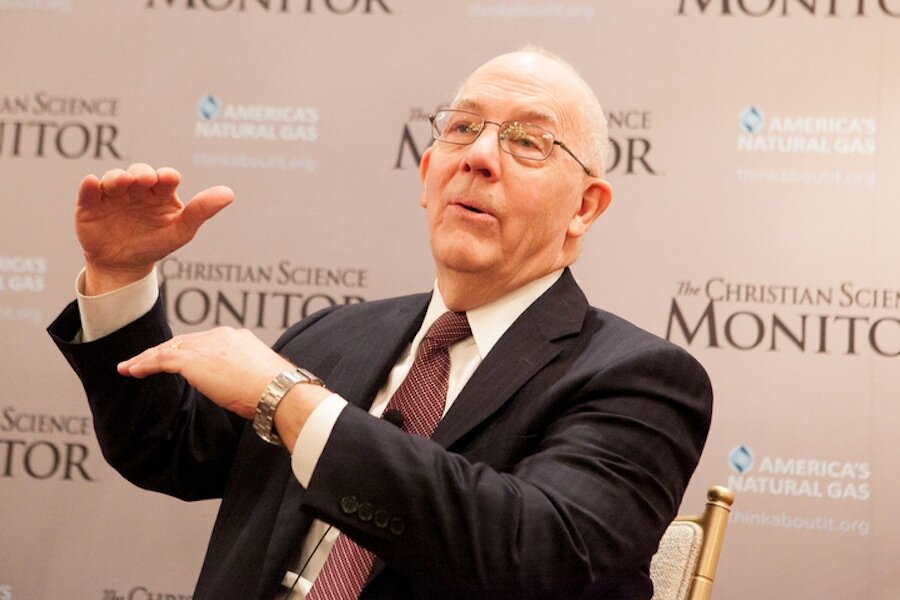EIA chief: Cheap oil won’t last forever
Loading...
| Washington
Beware the allure of cheap oil.
Crude prices may have slipped some 60 percent since last June to below $50 a barrel, encouraging motorists to buy SUVs and potentially eroding demand for alternative fuels. But when it comes to oil, what goes down likely must come up, US EIA administrator Adam Sieminski said at a Monitor-hosted conversation Wednesday in Washington.
Eventually, cheap prices will drive up demand for oil. The glut of oil will leave the market, and prices will likely find a new equilibrium – and because the drop in crude prices isn’t here to stay, consumers and investors should plan accordingly.
“It’s happened before, and it probably isn’t going to be permanent,” Mr. Sieminski says of cheap oil, citing the cyclical nature of the ever-fluctuating commodity.
Mr. Sieminski’s talk Wednesday was part of the launch of Recharge, the Monitor’s free weekly newsletter on global energy. Falling global oil prices, scaled-back US shale drilling plans, and a flurry of oil and gas policy shake-ups out of the Obama administration set the tenor for the event. Here’s a round-up of what Sieminski addressed:
Three big ideas:
1. Low oil prices are not here to stay. Sieminski put the current situation in perspective: “This is the sixth time in my career we’ve had an oil price crash,” he says, and prices have rallied as many times as they’ve fallen. Though he doesn’t expect oil prices to stay low, Sieminski declined to predict when prices will rise or where they’ll find equilibrium. “Making price projections is just about as risky as weather forecasts,” he says.
2. Cheap oil’s impacts go beyond North Dakota and Texas. Though marginal producers in shale plays from North Dakota to Texas take the toughest hits amid low prices, the rest of the economy isn’t off scot-free. The steel industry will contract as drilling companies scale back and require less pipe, Sieminski says, and other effects will ripple through the broader economy. Still, cheap crude is likely a net-positive for the US, Sieminski says, and not just for consumers who will save more than $700 next year because of cheap gasoline. “The drop we’ve seen in energy prices is probably going to add to the GDP numbers in 2015 to a significant level,” he says.
3. Renewables aren’t imperiled by cheap oil and natural gas. Bottom of the barrel prices on oil and natural gas make buying them more appealing, but that doesn’t mean renewables will be pushed out of the market, as the Guardian reported after the event. For one, renewable sources of electricity like solar and wind don’t often compete directly with oil, which more commonly fuels transportation than power plants. Second, many states already have goals and policies in place to support or require investment in renewables, and cheal oil won’t change that. And third, as Sieminski points out, the push for renewables and eco-friendly electric cars isn’t just market driven – there’s also a social component, a desire to be green. “Is the growth in all electric vehicles really being driven by gasoline prices, or is it social?” he asked.
Two notable quotes:
In response to Obama’s plan to restrict Arctic drilling and open Atlantic drilling: “Anything that’s associated with leasing activity on the outer continental shelf is probably something that’s not going to make much of a difference to production in the US for a decade,” Sieminski said, adding that, in the current environment, already “companies are struggling to maintain capital investments in their shale and conventional plays in the US.”
On cheap oil: “It’s happened before, and it probably isn’t going to be permanent,” Sieminski said. “We should learn – all of us, and this includes me and all of the Energy Information Administration – that just because something lasts for three or four years doesn’t mean it’s forever.”
Tweet of the day:
Click here for more information and to sign up for Recharge.





